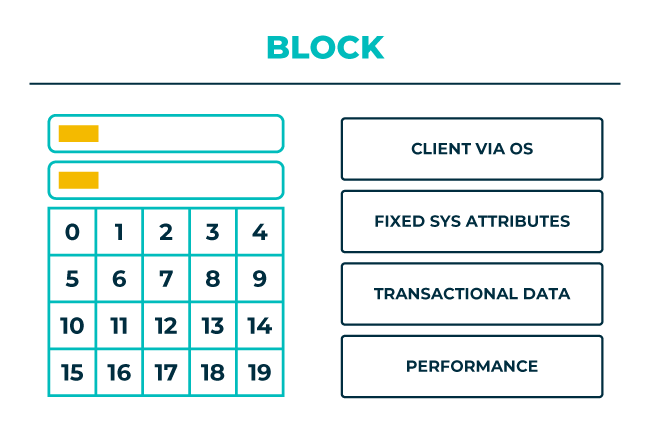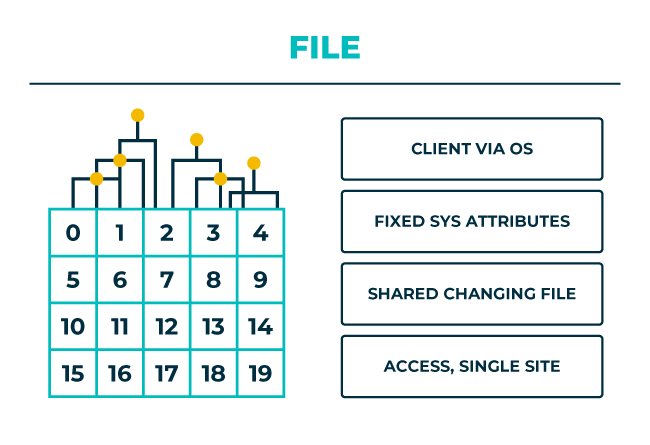Does “unleash your data” or “a new vision for data” sound familiar?
These popular statements from storage infrastructure providers are used in an effort to simplify the complex process of storing and providing data access to the necessary parties and processes.
Ultimately, your data is your business. Having the right data, at the right time, helps people to make smarter and more informed decisions about their business.
It follows, then, that the right storage infrastructure that facilitates data delivery in the most streamlined and economical way to the person or process that needs it is also a critical element in enabling better business decisions.
So why is it so hard to figure out what type of storage you need?

This post will provide a high-level explanation of each storage technology: block, file, and object, and the role that each type of storage plays in influencing business decisions. After all, today’s organizations can have file interfaces on object storage and object interface on file storage, so understanding the original function of each storage approach will help you as you evaluate storage technologies and how they map to your specific business requirements.
From a technical perspective, making better business decisions starts with the underlying storage architecture and the external interface.
Block Storage Brings Structure
The foundation for all external types of storage is block storage. With block storage, data is stored in bytes (8 bits) and blocked into segments that each have their own address.
What is block storage?
From an external perspective, this is the rawest form of storage – it’s like a blank slate for system software such as databases and operating systems to run on. The data block serves as an abstraction for what is going on above it. The sub-system knows the address of the blocks (data segments) and can update specific blocks.
Software and other data structure like files are made of thousands of blocks and because block storage can update granular segments, this makes it ideal for low latency, high transaction environments. If something changes, you only need to update a few blocks versus the entire piece of data.

When would you use block storage instead of object storage?
From a block storage perspective, high availability and performance are two very important characteristics. From a business decision perspective, block storage provides the foundation to support mission- and business-critical applications in a reliable, fast, and efficient manner.
File Storage Facilitates Collaboration
File storage is enabled by a global file system, which is a data structure that sits on top of block storage, that stores data in directories, sub-directories and filenames. The file system controls access to the files and governs file sharing, file locking, and manages all attributes of a file (such as creation, modification, access date, type, and size). Network-attached storage (NAS) devices fall in to the file storage category and provide storage over a wide-area network (WAN) or local area network (LAN).

The directory structure, file name, and managing of file access and attributes are what enables collaboration across organizations. You can have multiple people access and work on the same file, and the file system will manage those versions and updates accordingly based upon what a specific user is authorized to do. From a business decision perspective, file storage helps various users transform data into consumable pieces of information such as documents, images, audio, video, graphs, etc.
Object Storage Enables Long-Term Distributed Access
What is object storage?
Object storage solutions store data as objects on a disk that each get a unique key (also known as key/value storage or content addressable storage). All you need is that key to access the object (unstructured data like a document, photo, video, or audio). All object storage solutions are accessible via a RESTful interface over HTTP, which means all you need is access to the object storage system over the internet or an internal network and that key to access the content.

Object storage is ideal for large-scale data sets because object storage software can be installed on economical servers and data can move freely around the system. The object storage software can continue to add resources and continually optimize and balance the entire storage solution. By comparison, this is difficult to do with file storage because a file is locked into a specific directory/file name path.
Because of this approach, object storage is the foundation for all cloud storage services and is at the heart of all services that deliver unstructured data (audio services, video on-demand services, photo services etc.). From a business decision perspective, object storage helps many different end users and applications access and consume unstructured data in a simple way regardless of the data’s location.
On-Demand Webinar: The Differences Between Block, File and Object Storage and Why They Matter
If you would like to learn more, watch our on-demand webinar, ‘The Differences Between Block, File, and Object Storage and Why It Matters,’ featuring me and two of DataCore’s storage experts, Eric Dey, Product Manager, Object Storage, and Augie Gonzalez, Product Marketing Manager, Block and File Storage. In this recording, we examine the technological differences between these storage types and how organizations can leverage them to inform strategic business decisions.
Contact us to learn more.